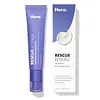What's inside
What's inside
 Key Ingredients
Key Ingredients

 Benefits
Benefits

 Concerns
Concerns

 Ingredients Side-by-side
Ingredients Side-by-side

Water
Skin ConditioningGlycerin
HumectantC13-15 Alkane
SolventSqualane
EmollientOctyldodecanol
EmollientButyrospermum Parkii Butter
Skin ConditioningPropanediol
SolventPolyglyceryl-4 Oleate
EmulsifyingCaprylic/Capric Triglyceride
MaskingMagnesium Sulfate
Polyglyceryl-6 Oleate
EmulsifyingPolyhydroxystearic Acid
EmulsifyingPanthenol
Skin ConditioningRetinol
Skin ConditioningResveratrol
AntioxidantPalmitoyl Tripeptide-38
Skin ConditioningGluconolactone
Skin ConditioningUbiquinone
AntioxidantEthyl Ferulate
AntioxidantCalcium Gluconate
HumectantAllantoin
Skin ConditioningBeta-Glucan
Skin ConditioningTocopherol
Antioxidant1,2-Hexanediol
Skin ConditioningXanthan Gum
EmulsifyingHelianthus Annuus Seed Oil
EmollientHumulus Lupulus Extract
AntimicrobialCopernicia Cerifera Cera
EmollientWater, Glycerin, C13-15 Alkane, Squalane, Octyldodecanol, Butyrospermum Parkii Butter, Propanediol, Polyglyceryl-4 Oleate, Caprylic/Capric Triglyceride, Magnesium Sulfate, Polyglyceryl-6 Oleate, Polyhydroxystearic Acid, Panthenol, Retinol, Resveratrol, Palmitoyl Tripeptide-38, Gluconolactone, Ubiquinone, Ethyl Ferulate, Calcium Gluconate, Allantoin, Beta-Glucan, Tocopherol, 1,2-Hexanediol, Xanthan Gum, Helianthus Annuus Seed Oil, Humulus Lupulus Extract, Copernicia Cerifera Cera
Water
Skin ConditioningIsopropyl Myristate
EmollientButylene Glycol
HumectantCaprylic/Capric Triglyceride
MaskingGlycerin
HumectantNiacinamide
SmoothingPentylene Glycol
Skin ConditioningAcrylates/C10-30 Alkyl Acrylate Crosspolymer
Emulsion StabilisingCetyl Alcohol
EmollientPolysorbate 20
EmulsifyingHexylresorcinol
AntimicrobialPhenoxyethanol
PreservativeRetinyl Propionate
Skin ConditioningDilauryl Thiodipropionate
AntioxidantDisodium EDTA
Pentaerythrityl Tetra-Di-T-Butyl Hydroxyhydrocinnamate
AntioxidantPotassium Hydroxide
BufferingPalmitic Acid
EmollientPhospholipids
Skin ConditioningLecithin
EmollientBHT
AntioxidantWater, Isopropyl Myristate, Butylene Glycol, Caprylic/Capric Triglyceride, Glycerin, Niacinamide, Pentylene Glycol, Acrylates/C10-30 Alkyl Acrylate Crosspolymer, Cetyl Alcohol, Polysorbate 20, Hexylresorcinol, Phenoxyethanol, Retinyl Propionate, Dilauryl Thiodipropionate, Disodium EDTA, Pentaerythrityl Tetra-Di-T-Butyl Hydroxyhydrocinnamate, Potassium Hydroxide, Palmitic Acid, Phospholipids, Lecithin, BHT
 Reviews
Reviews

Ingredients Explained
These ingredients are found in both products.
Ingredients higher up in an ingredient list are typically present in a larger amount.
This ingredient is an emollient, solvent, and texture enhancer. It is considered a skin-softener by helping the skin prevent moisture loss.
It helps thicken a product's formula and makes it easier to spread by dissolving clumping compounds.
Caprylic Triglyceride is made by combining glycerin with coconut oil, forming a clear liquid.
While there is an assumption Caprylic Triglyceride can clog pores due to it being derived from coconut oil, there is no research supporting this.
Learn more about Caprylic/Capric TriglycerideGlycerin is already naturally found in your skin. It helps moisturize and protect your skin.
A study from 2016 found glycerin to be more effective as a humectant than AHAs and hyaluronic acid.
As a humectant, it helps the skin stay hydrated by pulling moisture to your skin. The low molecular weight of glycerin allows it to pull moisture into the deeper layers of your skin.
Hydrated skin improves your skin barrier; Your skin barrier helps protect against irritants and bacteria.
Glycerin has also been found to have antimicrobial and antiviral properties. Due to these properties, glycerin is often used in wound and burn treatments.
In cosmetics, glycerin is usually derived from plants such as soybean or palm. However, it can also be sourced from animals, such as tallow or animal fat.
This ingredient is organic, colorless, odorless, and non-toxic.
Glycerin is the name for this ingredient in American English. British English uses Glycerol/Glycerine.
Learn more about GlycerinWater. It's the most common cosmetic ingredient of all. You'll usually see it at the top of ingredient lists, meaning that it makes up the largest part of the product.
So why is it so popular? Water most often acts as a solvent - this means that it helps dissolve other ingredients into the formulation.
You'll also recognize water as that liquid we all need to stay alive. If you see this, drink a glass of water. Stay hydrated!
Learn more about Water